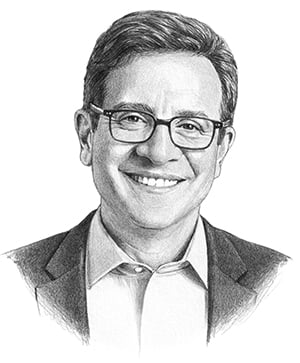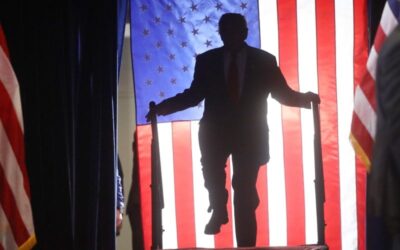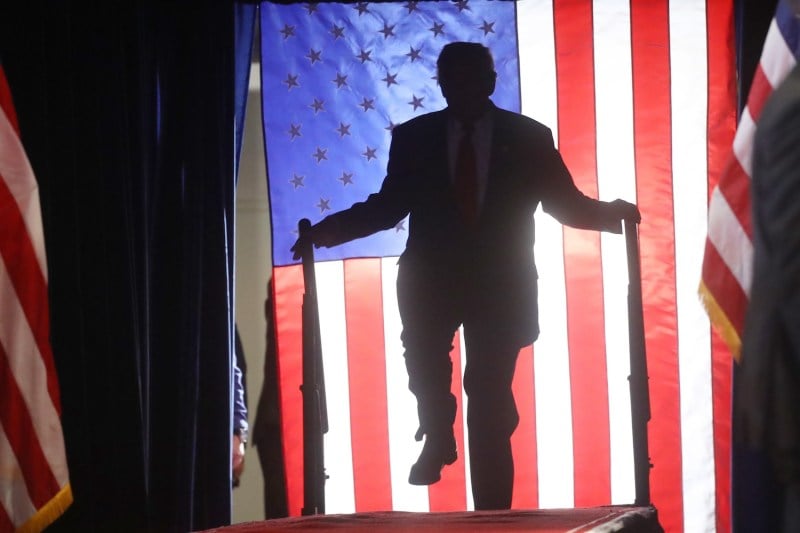Big Money in American Politics Started Here

Big Money in American Politics Started Here
How a 1976 Supreme Court decision paved the way for Elon Musk’s campaign in Wisconsin.
Elon Musk arrives for a town hall meeting at the KI Convention Center in Green Bay, Wisconsin, on March 30. Scott Olson/Getty Images
Democrats were elated with the outcome of the campaign to fill a seat on Wisconsin’s Supreme Court. Despite Elon Musk pumping $25 million into supporting Trump loyalist judge Brad Schimel, liberal Susan Crawford emerged victorious.
But the blow to Musk—and U.S. President Donald Trump—should not obscure the broader problem of how much money was spent on this race. According to the Brennan Center for Justice, this was the most expensive judicial race in American history, with spending totaling a whopping $100 million.
Democrats were elated with the outcome of the campaign to fill a seat on Wisconsin’s Supreme Court. Despite Elon Musk pumping $25 million into supporting Trump loyalist judge Brad Schimel, liberal Susan Crawford emerged victorious.
But the blow to Musk—and U.S. President Donald Trump—should not obscure the broader problem of how much money was spent on this race. According to the Brennan Center for Justice, this was the most expensive judicial race in American history, with spending totaling a whopping $100 million.
Nor were Democrats innocent bystanders. National liberal donors, including Illinois Gov. (and Hyatt hotel heir) JB Pritzker, spent millions as well to back Crawford’s successful campaign.
Unfortunately, the spending spree in Wisconsin is just the tip of the iceberg. Big spenders and big money dominate American politics.
Musk, who already owns one of the world’s most relevant social media platforms and biggest companies, jumped to the top of Trump’s universe toward the end of the 2024 campaign by contributing over $291 million to the campaigns of the former president and other Republican candidates. His generosity earned him a key spot in the administration, heading the Department of Government Efficiency (DOGE), a wrecking ball aimed at the federal workforce. Not to be trifled with, Musk has been making it clear that he intends to use his money in the midterm campaigns. Anyone who stands in the administration’s way knows that they could easily end up facing a primary challenger, paid for by Tesla’s boss.
Perhaps the most stunning aspect of these efforts is how big donors work through rather than around the legal process. Congress does not have the power to restrict independent expenditures, including Musk purchasing his own ads or paying for organizations that back the president. Large contributors have been everywhere in American politics for decades. This is one issue where both parties have been on the same page.
How did this happen?
Although private money has always been the “mother’s milk” of American politics, as the legendary California State Assembly Speaker Jesse Unruh once said, there was a moment when substantive campaign finance reform was at the center of the national agenda. In the aftermath of the Watergate scandal, which brought down President Richard Nixon in 1974, Congress attempted to restore trust in government by enacting sweeping campaign finance legislation.
On Oct. 15, 1974, Nixon’s successor, President Gerald Ford, grudgingly signed the Federal Election Campaign Act (FECA) Amendments of 1974 into law. The legislation created a voluntary public finance system for presidential campaigns. Candidates running for the party nomination could receive public funds for the primaries and general election if they accepted voluntary spending limitations. It imposed limitations on campaign contributions and campaign spending while strengthening disclosure laws. Candidates running for president were restricted to spending a maximum of $50,000 from their own funds. Finally, the Watergate reforms established the Federal Election Commission (FEC) to oversee the entire system.
Crucial to the legislation was the understanding that sometimes protecting the democratic process needed to be a priority over First Amendment concerns. Ford noted in his statement on signing the law that “there are certain periods in our nation’s history when it becomes necessary to face up to certain unpleasant truths. We have passed through one of those periods.” Reformers believed that the legislation constituted a historic victory in the struggle to curb the corrupting influence of money on elections. Though the legislation did not include much-desired provisions, such as public financing for congressional elections, the victory was nonetheless significant. As the founder of the good-government organization Common Cause, John Gardner, proclaimed, it was a “great half loaf.”
But it didn’t take long for the reforms to start falling apart. Almost as soon as the law went into effect, Sen. James Buckley, a member of the Conservative Party of New York State, teamed up with an eclectic coalition of allies that included the liberal former Minnesota senator and 1968 Democratic primary candidate Eugene McCarthy, the New York Civil Liberties Union, the Mississippi Republican Party and the Conservative Party of the State of New York. Buckley’s unwieldly coalition filed a suit against the secretary of the Senate, an ex officio member of the FEC, Francis Valeo. They argued that several components of the Watergate reforms were unconstitutional, and the case went on to be adjudicated in the highest court.
Under Chief Justice Warren Burger, the Supreme Court released its decision on Jan. 30, 1976. In a per curiam opinion, the court knocked down several key pillars of FECA. The court accepted a nuanced understanding of the need to balance concerns about corruption and the First Amendment. While the court legitimated the right of the government to limit campaign contributions, the justices deemed the restrictions on campaign spending to be a clear violation of free speech: “The First Amendment denies government the power to determine that spending to promote one’s political views is wasteful, excessive or unwise.” On the one hand, the court rejected the notion that large independent expenditures by candidates and individuals were the equivalent of corruption if there was an “absence of prearrangement or coordination … with the candidate or his agent.” Federal caps on contributions, it said, did not prevent individuals from supporting candidates. On the other hand, the court concluded that spending limits created a much more formidable barrier on the First Amendment since money was essential to speech: “[V]irtually every means of communicating ideas in today’s mass society requires the expenditure of money.” The dangers that high levels of spending could corrupt, or appear to corrupt, politics were not severe enough to justify the limitations on the speech, the court said. Moreover, the court knocked down restrictions on independent expenditures while simultaneously allowing for individual candidates to spend as much of their own money as they desired. In his dissent, Justice Thurgood Marshall quipped: “It would appear … that the candidate with a substantial personal fortune at his disposal is off to a significant ‘headstart.’”
Although Buckley v. Valeo did not destroy the rest of the Watergate reforms, the Supreme Court under Burger had opened a large door for private money to reenter the political bloodstream. Over the next several decades, campaign costs kept escalating. There was a massive expansion in the number of political action committees (PACs), and donors found new ways to get funds to candidates, including through “soft money” that went toward “party activities.” In contrast to individual candidates, these contributions were free from any federal restrictions. Without a full system of public finance, the incentives remained strong for candidates to scramble for private donations that were there for the taking as an attractive alternative to limited government dollars. The voluntary public finance system for presidential elections worked for many decades. But here, too, the lure of private money proved so strong that George W. Bush and then Barack Obama decided to forgo the public funds.
The Bipartisan Campaign Reform Act of 2002 imposed regulations on soft money, yet private money continued to find a way in. “Dark money” was a means of funneling funds through nonprofit organizations that were not required to report who their donors were. “Bundlers” were kingmakers who collected money from multiple donors, combining the dollars into a larger amount. Congressional opponents of campaign finance flattened the nuances of the Buckley decision and turned it into a straightforward ruling that “money is speech.” The mantra became the basis for going after all kinds of federal campaign rules. “The Court has held there is ‘nothing invidious, improper or unhealthy’ in campaign[s] spending money to communicate—nothing,” argued Kentucky Sen. Mitch McConnell.
Echoing the Burger court, a 5-4 majority on the Supreme Court struck another major blow to the campaign finance regulations with Citizens United v. FEC (2010). The decision removed corporate and union spending limitations based on the claim that they, too, violated the First Amendment. Four years later, in McCutcheon v. FEC, a 5-4 majority under Chief Justice John Roberts rejected aggregate limits on how much an individual could contribute to federal candidates and national parties over a two-year period.
In recent years, it has felt as if the Watergate-era hopes of containing the influence of private money in elections has all but vanished. All that remains is a disclosure system that serves the purpose of reminding voters of how much wealthy donors give and who are the beneficiaries. Frustrated politicians are trapped in a permanent fundraising scramble (which legislators refer to as the “call time” they spend every day) as they attempt to maintain sufficient coffers to ward off challengers. The election season is so long and so expensive that presidential candidates must start raising money almost as soon as the last election ends, or they will fall behind. Americans continue to pay the price, literally, for the Burger court’s decision with every single election.
Concerns about Musk’s influence should not lead Americans to overlook its underlying structural roots. The events in Wisconsin are not just a story about a few individuals—rather, the story is about a total system failure.
Proponents of reform remind us that there is legal room to challenge the court’s 1976 decision. As Gilad Edelman argued in The American Prospect more than a decade ago, the advent of the internet undermined the logic of the court’s decision, namely that speech in campaigns requires money. “What the Court in 1976 called ‘today’s mass society’ and ‘the modern setting,’” Edelman argued, “was a pre-digital era in which television, radio, and print were the inescapable gatekeepers of mass communication. Today’s mass society, connected by the Internet, has critically undermined the dependence of political speech on money.” Those trends only accelerated in the following years with the solidification of social media and the weakening of traditional media outlets.
Until Congress finds a way to address the broken system, whether through public funding or a constitutional amendment allowing for spending to be regulated, the nation will forever be locked in a spending arms race where big donors throw their weight around with the power of their purse.
As the guardrails of politics continue to fall apart in the second phase of the Trump era, the aggressiveness with which oligarchic forces will exercise their muscle over democracy will only worsen. If history is any guide, which it is, in the near future, Musk’s current role in politics will look tame.
This post is part of FP’s ongoing coverage of the Trump administration. Follow along here.
Julian E. Zelizer is a columnist at Foreign Policy and a professor of history and public affairs at Princeton University. His most recent book, In Defense of Partisanship, is published with Columbia Global Reports. He is the author of The Long View, a newsletter putting the news in perspective. X: @julianzelizer
More from Foreign Policy
-

An illustration shows a golden Cybertruck blasting through a U.S. seal of an eagle holding arrows and laurel. Is America a Kleptocracy?
Here’s how life could change for the rich, poor, and everyone in between.
-

The flag of the United States in New York City on Sept. 18, 2019. America Is Listing in a Gathering Storm
Alarms are clanging at the U.S. geographic military commands around the globe.
-

U.S. President Donald Trump shakes hands with Supreme Court Chief Justice John Roberts during Trump’s inauguration in Washington, D.C. The U.S. Judicial Crisis Is Uniquely Dangerous
But other democracies provide a roadmap for courts to prevail over attacks from the executive branch.
-

An illustration shows a golden Newtons cradle with Elon Musk depicted on the one at left and sending a globe-motif ball swinging at right. Elon Musk’s First Principles
The world’s richest man wants to apply the rules of physics to politics. What could go wrong?










Join the Conversation
Commenting on this and other recent articles is just one benefit of a Foreign Policy subscription.
Already a subscriber?
.
Subscribe
Subscribe
View Comments
Join the Conversation
Join the conversation on this and other recent Foreign Policy articles when you subscribe now.
Subscribe
Subscribe
Not your account?
View Comments
Join the Conversation
Please follow our comment guidelines, stay on topic, and be civil, courteous, and respectful of others’ beliefs.
Change your username |
Log out
Change your username:
CANCEL
Confirm your username to get started.
The default username below has been generated using the first name and last initial on your FP subscriber account. Usernames may be updated at any time and must not contain inappropriate or offensive language.